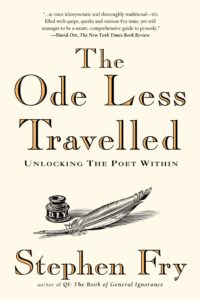Stephen Fry on Form, Part 9
 As I mentioned previously, I’m working through Stephen Fry’s The Ode Less Travelled very slowly to absorb as much wisdom as I can about writing poetry. This week’s post covers Chapter 3, Section 9, on “exotic” forms, which really just means “non-Western forms”.
As I mentioned previously, I’m working through Stephen Fry’s The Ode Less Travelled very slowly to absorb as much wisdom as I can about writing poetry. This week’s post covers Chapter 3, Section 9, on “exotic” forms, which really just means “non-Western forms”.
The forms in this chapter include the Japanese haiku, senryu, and tanka; the Persian ghazal; the Vietnamese luc bat; and the Philippine tanaga.
The Japanese forms are fairly well known in the Western world, at least the haiku. The senryu uses the same syllable count, but can be about humans rather than nature and doesn’t require a seasonal word. The tanka is a slightly longer, but still syllable-based form. It consists of five lines, with 5/7/5/7/7 syllables, so a haiku form plus two bonus lines.
The ghazal is a form I’m less familiar with, but it involves a short refrain that is repeated at the end of both lines of the first couplet, and the second line of remaining couplets. The syllable just before the refrain rhymes across the couplets, while the other lines are more free. And in the final line of the final couplet, the poet generally introduces themself. I think if I were going to try this form, I might have the subject of my poem introduce themself thusly, rather than putting myself into a poem. But that might be part of the nature of a speculative ghazal. It’s also worth noting that this form doesn’t rely on a syllable count, like the others in this section do.
Luc bat means “six eight” in Vietnamese, and that dictates the number of syllables in each line of this form. The rhyme scheme in a luc bat, though, involves rhyming the sixth syllable of an eight-syllable line with the final syllable of the six-syllable line above it, and so on throughout the poem. So depending on how many lines you write, you could have quite a chain of rhymes.
The final form in this section is the tanaga, which I hadn’t heard of before, but it, too, is a syllable based form, consisting of four lines, seven syllables each, which all rhyme. Traditionally, this is an aaaa rhyme, but Fry notes that modern tanagas have also been aabb, abab, and abba rhymes.
The exercise for this section is four haiku. Since I spent most of April (and some of May) writing haiku (including IN Japan), I’m gonna skip this exercise. I feel pretty good about haiku as a form.
Next up is the sonnet, where we put all that iambic pentameter to use!

Comments